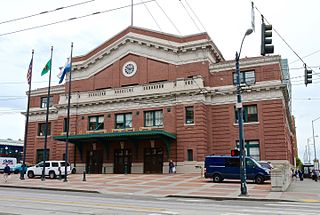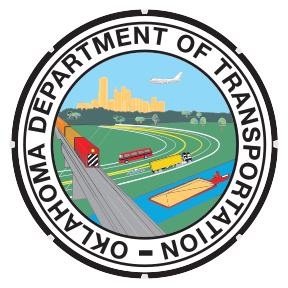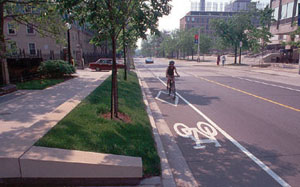Notable actions
In August 2005, TEN celebrated the signing of Safe Accountable Flexible and Efficient Transportation Equity Act-A Legacy for Users (SAFETEA-LU). TEN had worked with congressional representatives from both parties to ensure that language in the bill reflected TEN's priorities. In many cases, language in the bill matched TEN's language verbatim. The adopted language allowed for construction projects. The changes pushed by TEN required public participation plans to be developed with the involvement of local residents in the metropolitan transportation planning process. Changes in the legislation required greater transparency in the planning process and set aside $1 million each year for transportation equity research. TEN's work helped secure the Job Access and Reverse Commute Program by making it a formula program with a guaranteed $700 million over six years. [2]
TEN worked in 2005 with then-Senator Barack Obama to put workforce development language into a federal transportation authorization bill. This allowed local and state officials to craft local hiring agreements to create employment and training opportunities in the transportation construction sector. One early success was in St. Louis, Missouri, where TEN affiliate Metropolitan Congregations United brought the Missouri Department of Transportation to the table and won an agreement that 30% of the workforce on a $500 million highway project would be low-income apprentices and that 1/2 of 1% of the project budget ($2.5 million) would go to job training. [3] This became known as the Missouri Model. Recently, TEN won a commitment from Secretary of Transportation Ray LaHood to encourage state Departments of Transportation to adopt TEN’s “Green Construction Careers (Missouri Model)” of workforce development nationwide. [4] TEN also recently worked with Rep. Russ Carnahan to secure language in the jobs bill that passed the U.S. House of Representatives on December 17, 2009, to give transit authorities local control over spending priorities for up to 10 percent of the bill’s $8.4 billion in emergency public transit funding. [5] In December 2009, the Congressional Black Caucus lifted up TEN’s “Green Construction Careers (Missouri Model)” in an open letter to President Obama.

Barack Hussein Obama II is an American attorney and politician who served as the 44th president of the United States from 2009 to 2017. A member of the Democratic Party, he was the first African American to be elected to the presidency. He previously served as a U.S. senator from Illinois from 2005 to 2008.
Local hiring is a goal or requirement to hire people who live close to the place of work. This aim is often more specifically structured as a requirement for contractors awarded certain types of publicly funded projects to recruit a certain proportion of the people working on the project from a particular area.

The Missouri Department of Transportation is a state government organization in charge of maintaining public roadways of the U.S. state of Missouri.
TEN and its affiliates also pursue causes on a local level. In April 2010, TEN member Metropolitan Congregations United (MCU) and allies led a successful campaign in support of a ballot initiative to reinvest in transit in St. Louis city and county. Voters overwhelmingly supported the measure, which will provide $75 million a year to restore service cuts. [6] In the San Francisco Bay Area, TEN affiliate GENESIS was among several civil rights groups that filed a federal civil rights complaint and successfully stopped the use of $70 million in stimulus funds for a rail project that would have violated the Civil Rights Act. [7] Instead, the money will be used to avoid cuts in the region’s other transit lines. [8] In August 2010, in Kansas City, Missouri, TEN member MORE2 secured $11 million in local transit funding over 10 years, an increase of $5 million over previous levels. In Minnesota, TEN member ISAIAH successfully argued that a planned light rail line (the METRO Green Line) connecting Minneapolis and Saint Paul should include three additional stops in underserved, low-income communities. Also in Minnesota, after a five-year-long intensive campaign, ISAIAH convinced Minnesota Department of Transportation to dedicate $6.2 million in federal highway money over the next five years to training and apprenticeships in highway construction work to low-wage workers, people of color and women. [1] In October 2010, TEN affiliate MORE2 successfully worked to ensure that equity requirements would be included in the new TIGER II federal grants. [9]

St. Louis County is located in the far eastern portion of the U.S. state of Missouri. It is bounded by the city of St. Louis and the Mississippi River to the east, the Missouri River to the north, and the Meramec River to the south. As of the 2016 Census Bureau population estimate, the population was 998,581, making it the most populous county in Missouri. Its county seat is Clayton.

The Civil Rights Act of 1964 is a landmark civil rights and U.S. labor law in the United States that outlaws discrimination based on race, color, religion, sex, or national origin. It prohibits unequal application of voter registration requirements, and racial segregation in schools, employment, and public accommodations.

Kansas City is the largest city in the U.S. state of Missouri. According to the U.S. Census Bureau, the city had an estimated population of 488,943 in 2017, making it the 37th most-populous city in the United States. It is the central city of the Kansas City metropolitan area, which straddles the Kansas–Missouri state line. Kansas City was founded in the 1830s as a Missouri River port at its confluence with the Kansas River coming in from the west. On June 1, 1850 the town of Kansas was incorporated; shortly after came the establishment of the Kansas Territory. Confusion between the two ensued and the name Kansas City was assigned to distinguish them soon after.
Studies and reports
In January 2007, TEN released a study called The Road to Jobs, which used census] and other government data to the examine the employment of African Americans, Hispanics, and women in the construction field in 18 metropolitan areas. The study found that African-Americans, Latinos and women] are underrepresented compared to white men in every one of the 18 metropolitan areas. [10] TEN has since worked to incorporate workforce equity requirements into federal, state, and local transportation legislation.
African Americans are an ethnic group of Americans with total or partial ancestry from any of the black racial groups of Africa. The term typically refers to descendants of enslaved black people who are from the United States.
In September 2008, TEN released a follow-up study called The Road to Good Jobs. The report built upon the foundation laid in The Road to Jobs but went further in examining patterns of pay and union membership in construction across the nation's top twenty-five metropolitan areas. [9] [11]
In 2009, TEN and PolicyLink released a joint report entitled An Engine of Opportunity: A User’s Guide to Advocate for Transportation Equity in the 2009 Recovery Act . The report was designed as guide to activists, advocates, and journalists on the distribution of billions of dollars in transportation funding. The report also highlighted the key deadlines, reporting requirements and policy targets that were still to come that year. [12]
Later in 2009, TEN released a study co-authored by Transportation for America on the effects of service cuts on transit systems across the country. Entitled Stranded at the Station: The Impact of the Financial Crisis in Public Transportation, the study looked at the challenges facing 25 communities across the country. Many communities were facing record levels of ridership and simultaneously dealing with crippling budget and service cuts. The authors of the study found that failures on the federal level had compounded these problems and that older Americans and members of racial minorities were disproportionately affected by the cuts. [13]
In August 2010, a major study authored by TEN entitled More Transit = More Jobs was released. The study looked at 20 metropolitan areas and the potential effects of shifting 50% of highway spending to public transit. The report concluded that such a shift would create 1,123,674 new transit jobs over a five-year period in the 20 metropolitan areas. This would mean a net gain of 180,150 jobs over five years. The study was designed to demonstrate the positive impact of spending on public transit compared to spending highways. [14]

The United States Department of Transportation is a federal Cabinet department of the U.S. government concerned with transportation. It was established by an act of Congress on October 15, 1966, and began operation on April 1, 1967. It is governed by the United States Secretary of Transportation.
The Research Triangle Regional Public Transportation Authority, known as GoTriangle, provides regional bus service to the Research Triangle region of North Carolina in Wake, Durham, and Orange counties. The GoTriangle name was adopted in 2015 as part of the consolidated GoTransit branding scheme for the Triangle.

The Georgia Department of Transportation (GDOT) is the organization in charge of developing and maintaining all state and federal roadways in the U.S. state of Georgia. In addition to highways, the department also has a limited role in developing public transportation and general aviation programs. GDOT is headquartered in downtown Atlanta and is part of the executive branch of state government.

Sound Transit (ST), officially the Central Puget Sound Regional Transit Authority, is a public transit agency serving the Seattle metropolitan area in the U.S. state of Washington. It operates light rail service in Seattle and Tacoma, regional Sounder commuter rail, and Sound Transit Express bus service, as well as managing the regional ORCA fare card system. In 2017, Sound Transit services carried a total of 47 million passengers, including an average of 157,000 riders on weekdays.

The Washington Metropolitan Area Transit Authority, commonly referred to as Metro, is a tri-jurisdictional government agency that operates transit service in the Washington metropolitan area. WMATA was created by the United States Congress as an interstate compact between the District of Columbia, the State of Maryland, and the Commonwealth of Virginia.

A metropolitan planning organization (MPO) is a federally mandated and federally funded transportation policy-making organization in the United States that is made up of representatives from local government and governmental transportation authorities. They were created to ensure regional cooperation in transportation planning. MPOs were introduced by the Federal-Aid Highway Act of 1962, which required the formation of an MPO for any urbanized area (UZA) with a population greater than 50,000. Federal funding for transportation projects and programs are channeled through this planning process. Congress created MPOs in order to ensure that existing and future expenditures of governmental funds for transportation projects and programs are based on a continuing, cooperative, and comprehensive (“3‑C”) planning process. Statewide and metropolitan transportation planning processes are governed by federal law. Transparency through public access to participation in the planning process and electronic publication of plans now is required by federal law. As of 2015, there are 408 MPOs in the United States.
The Charlotte Area Transit System, commonly referred to as CATS, is the public transit system in Charlotte, North Carolina, United States. It operates bus and rail service around the Charlotte metropolitan area. This includes a bus rapid transit line called the Sprinter, a light rail line called the LYNX Blue Line, and a streetcar line called CityLYNX Gold Line.
The Safe, Accountable, Flexible, Efficient Transportation Equity Act: A Legacy for Users was a funding and authorization bill that governed United States federal surface transportation spending. It was signed into law by President George W. Bush on August 10, 2005, and expired on September 30, 2009.

Metro Transit is an enterprise of Bi-State Development, an interstate compact formed by Missouri and Illinois in 1949. Its operating budget in 2016 was $280 million, which is funded by sales taxes from the City of St. Louis and St. Louis County, the St. Clair County Illinois Transit District, federal and state grants and subsidies, and through fare paying passengers.

The Oklahoma Department of Transportation (ODOT) is an agency of the government of Oklahoma responsible for the construction and maintenance of the state's transportation infrastructure. Under the leadership of the Oklahoma Secretary of Transportation and ODOT Executive Director, the Department maintains public infrastructure that includes highways and state-owned railroads. Along with the Oklahoma Turnpike Authority, the Department is the primary infrastructure construction and maintenance agency of the State.

Complete streets is a transportation policy and design approach that requires streets to be planned, designed, operated, and maintained to enable safe, convenient and comfortable travel and access for users of all ages and abilities regardless of their mode of transportation. Complete Streets allow for safe travel by those walking, cycling, driving automobiles, riding public transportation, or delivering goods.

The Regional Connector Transit Corridor is a light rail tunnel connection currently being built through Downtown Los Angeles to connect the current Metro Rail Blue and Expo Lines to the current Gold Line and Union Station. When completed, the project will provide a one-seat ride into the core of Downtown LA for passengers on these lines who currently need to transfer, and will reduce or eliminate transfers for many passengers traveling across the region via downtown.
The Bottineau LRT is a proposed light rail line extension in the Minneapolis – Saint Paul Metro area, projected to run northwest from downtown Minneapolis along County Road 81 to Brooklyn Park. If built, Bottineau LRT would be the next light rail line in the Twin Cities after the Southwest LRT.

The Transportation Expansion (T-REX) Project was a $1.67 billion venture that had a goal of transforming the way people in the metro Denver area commute within the areas of Interstates 25 and 225, then the country's 14th busiest intersection. The T-REX effort widened major interstates to as much as 7 lanes wide in each direction and added 19 miles (31 km) of double-track light rail throughout the metropolitan area. It's considered by some to be one of the most successful transportation upgrade projects in the United States. It also received a National Design-Build Award from the Design-Build Institute of America. The T-REX project finished 3.2% under its $1.67B budget and 22 months ahead of schedule in 2006 and is considered to be an example of inter-governmental agency cooperation for transportation projects for North America and Worldwide. Stakeholders have been recognized nationally and internationally for its success, including quality management.
The Puget Sound Regional Council (PSRC) is a metropolitan planning organization that develops policies and makes decisions about transportation planning, economic development, and growth management throughout the four-county Seattle metropolitan area surrounding Puget Sound. It is a forum for cities, towns, counties, transit agencies, port districts, Native American tribes, and state agencies to address regional issues.
Established in 1902, the Washington, D.C.-based American Road & Transportation Builders Association (ARTBA) advocates strong investment in transportation infrastructure.
Transit for Livable Communities (TLC) is a regional, nonpartisan transit, biking, walking, and development advocacy group based in St. Paul, Minnesota, USA. It was founded in 1996 by Barb Thoman and John DeWitt.

The District Department of Transportation (DDOT) is an agency of the government of the District of Columbia which manages and maintains publicly owned transportation infrastructure in the District of Columbia. DDOT is the lead agency with authority over the planning, design, construction, and maintenance of alleys, bridges, sidewalks, streets, street lights, and traffic signals in the District of Columbia.
The Surface and Air Transportation Program Extension Act of 2011 became a United States law when President Barack Obama signed the Act on September 16, 2011 (Public Law No. 112-30. The law extends taxes which fund federal highway expenditures through March and the Federal Aviation Administration through January. The Surface and Air Transportation Programs Extension Act of 2011 is a direct result of an agreement which was reached by the House and Senate majority leaders. This extension act was a top priority to Congress because federal highway and FAA funding was about to expire.


















